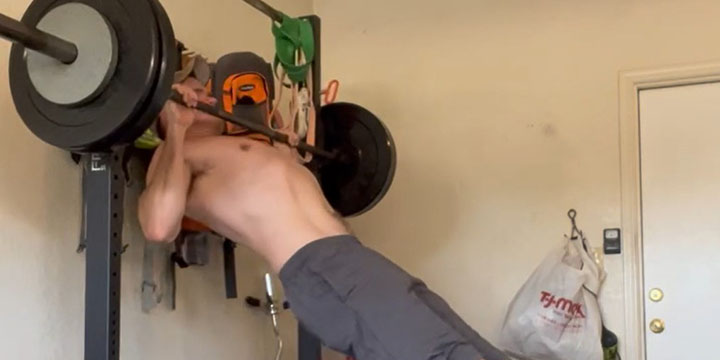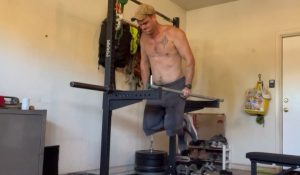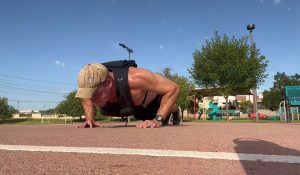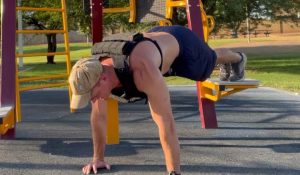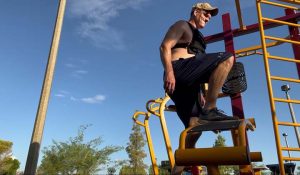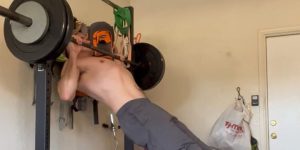One of the most classic benchmarks in strength and fitness is our ability to do pull-ups. However, it’s often the case that people struggle to get their first pull-up, or they can only do one or two. Getting over the hump of being able to more than just one or two pull-ups per set can be quite a challenge.
If this describes you, then it makes a lot of sense to utilize some specific exercises to help with pull-ups, and devote some training attention to it for a little while until doing pull-ups becomes just like any other exercise.
The challenge with learning the pull-up
The main challenge folks run into when trying to incorporate pull-ups into their strength training for the first time is that the pull-up itself is a fairly “heavy” exercise. If you’re not strong enough to pull your entire body weight, then the whole exercise can seem like a non-starter.
I often draw the analogy of someone learning to squat for the first time. Does it make sense to force a new squatter to load the bar with 225lbs on his first day of training? Of course not! The solution is obvious: start with a lighter weight.
Most of us squatted the bar first, or even started with a dumbbell goblet squat in order to learn the movement pattern, then we load the movement with progressively heavier weights over the course of months and years.
With pull-ups, you’re stuck with your body weight. If you weigh 210, and you can’t pull 210, then you’re going to struggle.
This means that it’s tough to teach someone the actual movement pattern of the pull-up or chin-up without them first being strong enough – a true catch-22.
Criteria to determine what exercises help pull-ups
The key to determining which exercises to help improve your pull-up performance lies in a couple of factors:
Is the movement specific enough to our goal? Essentially, how similar is the exercise to the pull-up itself? Often we’re told to add lots of bicep curls to our routine or “just do inverted rows” until we can do a pull-up. I’ve written in the past about how I don’t believe the inverted row helps with pull-ups as much as many folks insist. The reason? It’s a totally different movement.
Can we deload the movement? If strength is the limiting factor, then we must be able to mimic the pull-up movement while decreasing the strength requirement.
After working with numerous people on getting their first few pull-ups, I believe the following 5 exercises have the most value for getting over the “hump” and on to a more intensive pull-up program.
Best exercises to improve pull-ups
After much experimentation, I’ve found that the following 5 exercises are the best at checking the boxes above:
1. Negative pull-ups
Honestly, when it comes to improving at pull-ups, it’s hard to argue against using the negative pull-up as a primary strength builder. In fact, the exercise program that I personally used to get my first few pull-ups many years ago was basically a grease-the-groove method using negative pull-ups.
The benefit is that we’re actually controlling our entire body weight while mimicking the pull-up movement exactly. In addition to developing strength, we can gain the skill of “controlling the swing” by doing negatives.
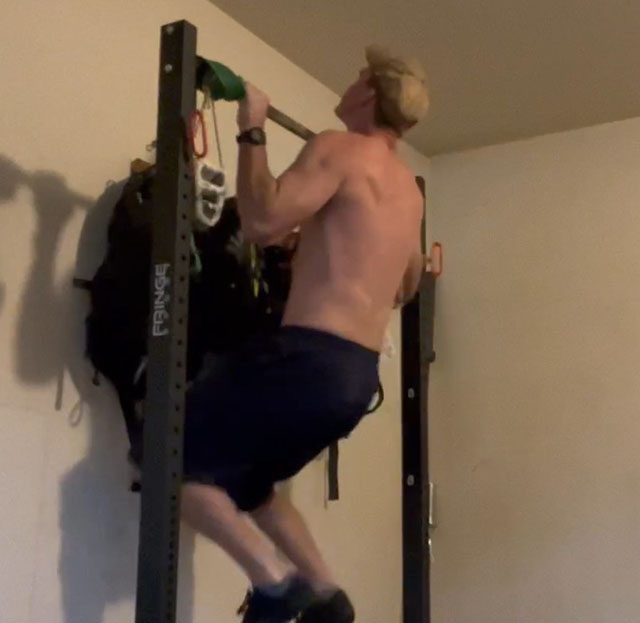

How to do it: Negative pull-ups are simply the eccentric portion of a pull-up with the concentric portion taken out. To do it, get yourself a chair, bench, or box that you can use to raise your body to the top of the pull-up bar. Grab the bar with your preferred pull-up grip and step off the surface.
Hold at the top for a second or two, then lower your body to the bottom of a pull-up over two to three seconds. Make sure to utilize a full range of motion and allow the lats to stretch. Once at the bottom, release the tension, step back onto the bar, and repeat for the desired number of reps.
2. Jackknife pull-ups
I’ve spoken elsewhere about my fondness for the benefits of jackknife pull-ups and chin-ups, even for people who are strong enough to do regular pull-ups. I think as an assistance or hypertrophy exercise, they are fantastic because they allow us to do pull-ups in much higher rep ranges. They can be easily loaded using a weighted vest or plate across the thighs.
The angle at which you’ll pull your body is slightly different, but not much. The only downside to the jackknife pull-up is that you won’t learn to control the swing like you would in a regular pull-up or negative pull-up.

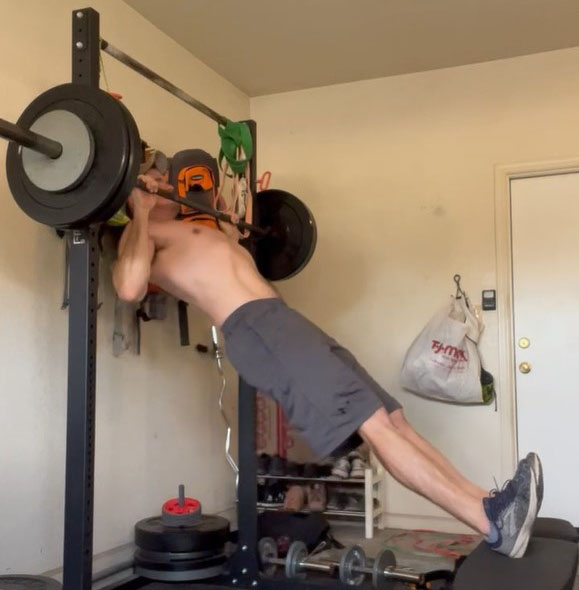
How to do it: Jackknife pull-ups may seem awkward at first, but after you try them you’ll see the beauty of this underrated exercise. Simply place a bar, rings, or TRX straps about halfway between normal pull-up bar height and the waist height you’d use in an inverted row.
Place a chair, bench, or box directly in front of you, grasp the bar with a normal pull-up or chin-up grip, and place your feet on the surface in front of you.
Viola! You’re now able to do pull-ups with a significantly decreased resistance. This exercise is fantastic for learning the movement pattern while building muscle in the key areas required to do normal pull-ups.
3. Resistance band-assisted pull-ups
Resistance band-assisted pull-ups have their drawbacks, but the fact remains that they are one of the best ways to build the requisite strength and muscle to work up to a full pull-up. The advantage here is that we can really dial in the resistance by choosing the appropriate band for the rep range we’re trying to target.
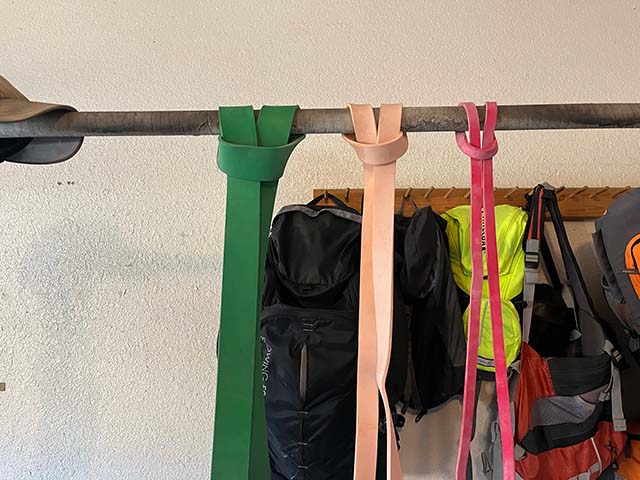
How to do it: Wrap a band over the bar and loop it through itself. Place a foot or knee into the band, lower your body to the bottom of the pull-up, and complete a normal set of pull-ups.
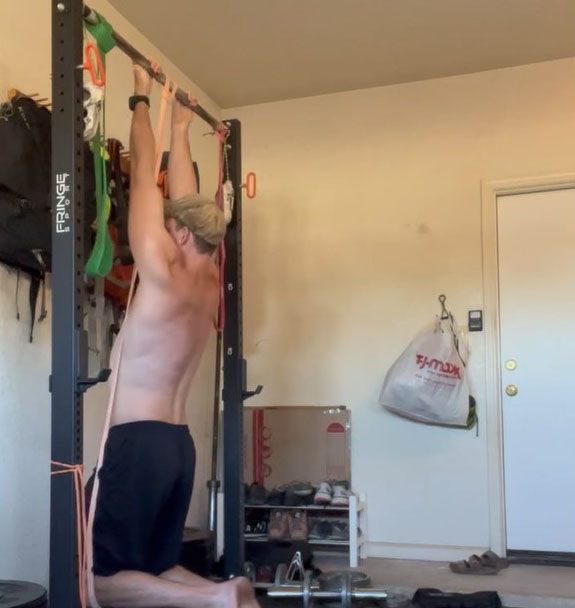

As an aside, the trouble with resistance band-assisted pull-ups is that as the band lengthens, it assists us more (in the bottom), and as it compresses, it helps us less (at the top). This means that the band helps the most in the position where we need it the least.
Despite this drawback, the band-assisted pull-up is a very viable option as an accessory for anyone looking to get more pull-up specific volume into their program. It was even a favorite of the late bodybuilder John Meadows for creating a great pump in the lats.
4. Machine-assisted pull-ups
It should come as no surprise that machine-assisted pull-ups are one of the most viable options for developing pull-up strength. I won’t spend a lot of time discussing the technique as it is fairly self-explanatory.
However, I will say that the main drawback of this exercise is not the exercise itself. It’s the fact that most of us who are working out in our garages or backyards don’t have access to a dedicated assisted pull-up machine without going to a gym.
If you’ve got a gym membership, then this is a fantastic option. If not, you may want to try using the three options above instead.
5. Partner-assisted pull-ups
If you work out with a partner or buddy, then having the other person deload your pull-up by holding your feet is another excellent option.
This variation of an assisted pull-up relies on your workout partner’s ability to dial in the appropriate level of resistance. Make sure to tell your partner in advance how much assistance you would like, and how much they should help when you begin to struggle.
Non-specific muscle-building assistance exercises for pull-ups
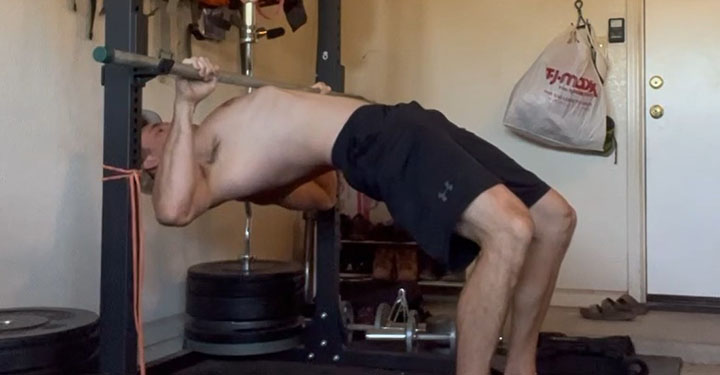
There are numerous true “assistance” exercises that can be helpful in developing the specific musculature required to complete pull-ups for reps. The exercises below are helpful, just don’t rely on them as a main driver of pull-up strength:
- Curl and reverse curl variations
- Dead hangs on a bar, rings, or with towels (grip strength work)
- Dumbbell, barbell, or cable rows
- Bodyweight (inverted) row variations
- Lat pull-downs
Including 2-3 sets of one of the above exercises per session definitely won’t hurt, and the variation will also likely help you maintain elbow health and shoulder strength with simple body weight exercises.
Putting it all together
An entire article could be written on how to put all of these exercises together, but in general, there are two approaches that I recommend for putting these exercises into practice. The first is the grease-the-groove method, and the other is a more traditional approach with workout sessions dedicated to improving pull-up strength.
To design a pull-up specific development session, use the following template:
- Exercise A: Strength work. Pick a variation from the list above that allows you to get 2-4 repetitions per set, and complete three sets, resting about three minutes between sets.
- Exercise B: Hypertrophy work. Pick a variation from the list above that allows you to get between 6-15 repetitions per set, and complete three sets, resting about two minutes between sets.
- Exercise C: Assistance. Pick an exercise from the assistance exercises listed above and complete 2-3 sets, resting for 1-2 minutes per set.
Completing two or three variations of the above template should have you doing full pull-ups within (at most) a month or so.
Remember that doing pull-up specific sessions is only temporary. Once you’re able to do pull-ups, you can simply include them in a more traditional program as one of the exercises in an upper/lower split, a full-body routine, or a push/pull/legs routine.
Good luck!
